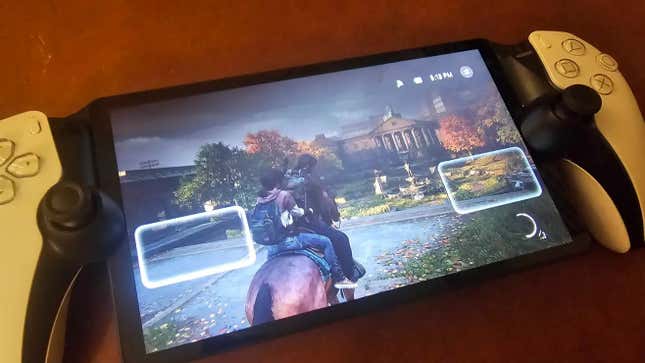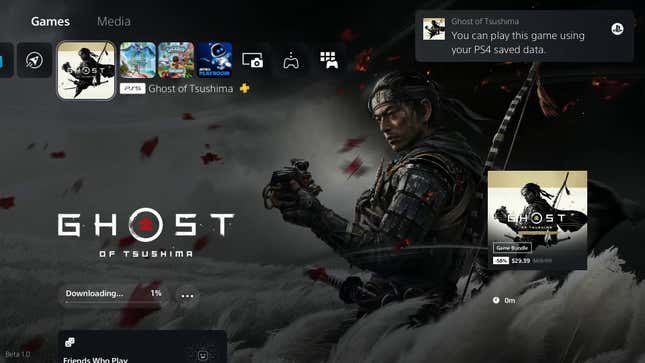A slick new VR headset, a “slim” console refresh, tons of flashy new accessories, and multiple exclusives, including the fastest selling PlayStation game ever, Spider-Man 2. The PlayStation 5 made big moves in 2023. So why does it feel like the console spent most of it resting on its laurels while flailing for a new direction?
It’s a strange time for PlayStation. Sony boasted to investors a target of 25 million consoles sold this fiscal year, while at the same time remaining almost completely silent about the upcoming prestige blockbusters the company’s known for. The PS5 now truly feels positioned to be the best platform Sony’s ever had, but it’s unclear what exactly comes next. A massive pivot to live-service games? A more powerful PS5 Pro? Uncharted 5?
Two things make a console great: its current games and its future ones. With the benefit of PS4 backwards compatibility, ongoing software updates, and a steady slate of new hits, the PS5 is, by all accounts, a stellar gaming platform. At the same time, layoffs, high-profile departures, and game cancellations make it hard to know what will come next. It also doesn’t help that Sony is acting more secretive than ever. 2023 was the year Spider-Man 2 gave people a reason to buy a PS5. It was also the year where things got very, very weird.
The Hardware
The PlayStation ecosystem was inundated with new gadgets this year, though most felt focused on appealing to existing niches. PS VR2 offered a pricey upgrade to Sony’s existing virtual reality platform. The improvements, led by the most comfortable headset on the market, were noticeable, but didn’t move the needle on broader adoption. The lack of backwards compatibility and big new VR games didn’t help.
Sony has all but abandoned the initiative since an initial State of Play revealed a bunch of new and existing ports heading to the platform. Horizon: Call of the Mountain was an impressive first-party show piece for PS VR2, yet there’s no sign that other big first-party spin-offs are on the way. If you have the latest headset, you could be forgiven for feeling all but abandoned within months of its release.
The DualSense Edge was also an expensive upgrade, increasing the build quality of the existing PS5 controller and expanding its versatility and repairability. It’s another “if you can afford it, sure why not” addition to the PS5 ecosystem. “If you’re not the sickest of online-playing sickos, much of the perks the DualSense offers feel like a luxury,” Kotaku’s Kenneth Shepherd wrote in his review. “It’s objectively better than playing with a standard controller, but it comes at such a steep price.”

They same applies to the new PlayStation Pulse earbuds. Great for low-latency 3D audio while also featuring planar magnetic drivers for better sound quality, the $200 add-on nevertheless lacks things like noise canceling or pass-through. It’s a mixed-bag in a head-to-head matchup with Sony’s own competing InZone gaming earbuds. For the price, the Pulse earbuds probably could have done a better job of nailing the trade-offs for a less compromised feature set.
Nothing exemplified this trend more than the PlayStation Portal, a goofy-looking yet surprisingly sturdy and comfortable remote play handheld seemingly designed to appeal to a couple thousand diehard PlayStation fans. Another $200 accessory, it’s basically a DualSense with an LCD screen wedged in-between. There’s an Android OS, but no functionality outside of streaming games from an existing PS5, the results of which are decent but vary depending on WiFi speed.
It’s the perfect boondoggle for grinding out PlayStation trophies in bed, during football games, or while the kids are watching Bluey. The question remains, however, why didn’t Sony go the extra mile and make a more capable handheld that could also stream games from the cloud, or even play some natively? Maybe one is coming in the future. Or maybe the Portal is proof that while every other company is racing to make its own version of the Nintendo Switch and Steam Deck, Sony is content to never once again dare to fumble portable gaming as badly as it did with the PS Vita.
Sony concluded 2023 with a slight refresh of the PS5 itself. A new “slim” version is 30 percent lighter and comes with a swappable disc drive and a full 1TB SSD instead of the launch edition’s 800GB one. Otherwise, while the internal configuration shifted to bring down manufacturing costs, it’s effectively the same machine at a slightly higher price for the all-digital version, which starts at $450 now instead of $400.
The detachable disc drive, meanwhile, is $70 standalone and requires an internet connection upon setup to bypass DRM, much to the chagrin of gaming preservationists. It doesn’t look quite as sleek as past slim redesigns, complicating the PS5’s already unusual aircraft hangar style with an ugly black line across the middle. All of it—the console, VR headset, DualSense Edge, PlayStation Portal, and Pulse earbuds—can be yours for the not-so-low price of $1,650.
The Software
The PS5 interface was pretty barebones when it launched in 2020, missing many of the features players had become accustomed to on the PS4. This was the year some big firmware updates brought over those improvements, as well as plenty of new ones. While headlined by the addition of Discord integration, March’s 7.0 update streamlined things across the board, from notifications for when you have existing save data for a game in the cloud to less friction when trying to view and join friends’ gaming sessions.
Game folders, the big addition last year, received the ability to filter games too in 2021. Choosing which games to add is one of those small but meaningful tweaks that makes managing a growing digital library less of a chore. A September update added even more features, including the ability to search folders and finally turn off the beeping sounds whenever the PS5 turns on. The PlayStation Store also became friendlier, adding accessibility tags to let players know which games have which customization options before they buy.

Plenty of headaches remain, though. There’s no way to add folders directly to the main row of icons on the home screen, and lots of settings and features are still buried beneath too many unintuitive button presses. Social features are pegged to the Control Center that pops up when you press the home button, while managing data storage and other key functions are cordoned off in the top right of the home menu. And I still always mess up how to turn the console off.
Sony also ended Twitter integration on PS5 this year as it pivots social media sharing to the smartphone PS App. The PlayStation Stars rewards program added there still feels weirdly siloed as well. You can only initiate “campaigns” to earn coins redeemable for PSN cash from the app, and the collectibles you unlock can’t be viewed on PS5 either. It’s a neat idea that’s still incomplete, similar to Activity Cards, the console’s tool for keeping track of discrete challenges within a game and helping you complete them more efficiently.
The cards were great in Spider-Man 2, letting players warp around the map even quicker than the in-game fast-travel system to clean up those last few side-missions and collectibles. Implementation in non-first-party games is uneven though, and the cards aren’t always cleanly laid out and organized. Like Sony’s scattershot approach to hardware and accessories, the interface is full of good ideas that aren’t necessarily all pulling in the same direction. It’s messy, and in need of a more foundational overhaul than just another set of new features and tweaks. In the meantime, I’d love for trophy lists to stop defaulting to hidden even after I’ve revealed them and to finally be able to add folders to the home screen.
The Network and Services
Last year was the big PlayStation Plus revamp. This year Sony continued adding PlayStation classics to the subscription services’ back catalog and finally implemented cloud streaming for many of the PS5’s biggest games. It also dramatically raised the price of each tier of the new program, making it feel like a good time to really consider whether renting a vast library of games every month is better than just paying to own the ones you actually want to play outright.
The annual prices went from $60 to $80 for Essential, $100 to $135 for Extra, and $120 to $160 for Premium. The bottom tier added plenty of great games this year, from Star Wars Jedi: Fallen Order and OlliOlliWorld to Death’s Door and Callisto Protocol. The Extra tier’s Netflix-like library circulated in heavy hitters as well, from Devil May Cry 5 and Borderlands 3 to Destiny 2: The Witch Queen and Grand Theft Auto 5. There were some notable day-and-date releases on the service too, like the PS5 version of Rogue Legacy 2 and the SNES-style RPG Sea of Stars. And Sony continued adding older first-party exclusives to the back catalog, like Horizon Forbidden West and Ratchet and Clank: Rift Apart.
The most expensive Premium tier was less impressive. Sony recently began rolling out cloud streaming on PS5, an additional perk that makes it easy to try a game before buying it or get started before finishing the download. Unfortunately, the performance, at least in my limited experience, isn’t great yet.

And the trickling out of PlayStation Classics, the main draw of the Premium tier for hardcore fans and retro enthusiasts, remains slow and full of random games that aren’t that exciting. Some months there are great additions like The Legend of Dragoon and Grandia. Other months, we get games like Ape Escape: On the Loose, the PSP remake of the original game which was already on the service. Some months no classics get added at all. Given that Sony sells them separately in the store anyway, anyone subscribed to Premium waiting for their favorite PS1, PS2, or PSP game would be better served by saving their money and just waiting until it’s available to buy.
At a time when rising prices are prompting everyone to reevaluate what subscriptions are actually worth holding onto, PlayStation Plus, feels harder than ever to justify—unless there’s a live-service multiplayer game you log into regularly, in which case it’s mandatory. The program keeps getting more complicated without actually getting much better in terms of value. As an example, Sony recently announced a rebrand of its movie streaming app and that PS Plus Premium subscribers would get access to a library of up to 100 movies.
Before you get too excited, the list included things ranging from Looper to Kingsglaive: Final Fantasy XV. It’s hard to know just how good of a deal this will end up being, but it doesn’t feel like the “super bundle” other services are chasing. I can see a future where Sony adds Funimation and Crunchyroll to PS Plus to sweeten the deal. Instead, this year the company retired the PS Plus Collection, a great onboarding perk for new PS5 owners that included excellent games like Nier Automata and Persona 5 Royal in the base version of PS Plus.
The Games
A modest year for PlayStation exclusives can feel dire, but 2023 was surprisingly robust, thanks in large part to somestellar third-party games. On the Sony front, there was the unsurprising but technically impressive PS VR2 launch title Horizon: Call of the Mountain in February. Forbidden West’s expansion, Burning Shores, an epilogue to the sci-fi open-world game that delivered PS5-exclusive visual effects and one hell of a final boss fight, followed in April. The marquee event was Spider-Man 2, a showpiece for the PS5 that highlighted what’s possible on the new hardware, from lightning-quick load times and spectacular setpieces, to immersive integration of the DualSense controller’s haptic triggers and 3D audio. There wasn’t a clear reason to buy Sony’s new console before, but Venom changed that. All 19 inches of it.

Other exclusives helped fill in the gaps. Square Enix’s magical action-adventure Forspoken made the internet cringe with its Whedonesque quips, but there was a solid game under the hood. Final Fantasy XVI, the latest entry in the storied RPG series, has its fair share of problems from a storytelling perspective, yet still offered some incredible character performances and a winning combat system complete with Kaiju boss fights that set the bar for peak gaming drama. Then there was Baldur’s Gate 3, the D&D-based GOTY that accidentally became a timed console exclusive. (You can thank the Xbox Series S for that one.)
In what was overall one of the best years for game releases in recent memory, and possibly ever, almost all of them were available on PS5: Resident Evil 4 remake, Star Wars Jedi: Survivor, Diablo IV, Street Fighter 6, Cyberpunk 2077: Phantom Liberty, Alan Wake II, and Avatar: Frontiers of Pandora. And after all that, Sony topped the year off with the God of War Ragnarok Valhalla DLC, a story-driven roguelite mode that was way too good to be free. Seriously, Sony Santa Monica probably should have just asked for at least $10. (Naughty Dog is for TLOU 2 Remastered.)
The Future
At present, the PS5 is a console gaming juggernaut. Can it stay that way? As the ground gave way beneath the video game industry this year, Sony wasn’t immune. It closed PixelOpus, the small team behind Concrete Genie and the latest sign that PlayStation’s more experimental and creatively daring days of the PS3 and early PS4 years are behind it.
Media Molecule, the team behind Dreams, Sony’s intelligent and bespoke riff on Roblox, also suffered layoffs as it brought post-launch support for the ambitious user-friendly game development tools platform to a close. The puzzle game Tren served as a finale of sorts, a lovely window into the studio’s playful spirit. While less severe, there were cuts across other internal PlayStation teams from Visual Arts to Insomniac Games.
Then there’s the intertwined fates of Bungie and Naughty Dog. The Last of Us Online, possibly one of the crown jewels in Sony’s dramatic promise to ship 12 live-service games by the end of 2025, was suddenly canceled this month after years of datamined leaks and teases. Bloomberg reported in May that development had been downsized after a negative internal review by experts at Bungie. By October, Naughty Dog was letting go dozens of contractors with the project indefinitely frozen. What went wrong?
“To release and support The Last of Us Online we’d have to put all our studio resources behind supporting post launch content for years to come, severely impacting development on future single-player games,” Naughty Dog wrote in a blog post on December 14. “So, we had two paths in front of us: become a solely live service games studio or continue to focus on single-player narrative games that have defined Naughty Dog’s heritage.”

While this was happening, Bungie, which has so far remained independent within PlayStation, suffered 100 layoffs of its own following a reported 45 percent shortfall in revenue after 2023’s Lightfall expansion failed to live up to expectations. The studio that was evaluating The Last of Us Online’s scope and feasibility is now at risk of having its board of directors dissolved, with Sony taking over full control of the storied Halo maker. Destiny 2’s next expansion, The Final Shape, was delayed from February 2024 to June, and Marathon, its recently revealed extraction shooter, was delayed to 2025.
These dual episodes cast even more doubt on Sony’s stated live-service ambitions, which include a Horizon multiplayer spin-off and presumably similar online variants of existing franchises across the rest of the first-party portfolio. As other live-service games flop or get canceled, it’s not clear that the pivot will be any more sustainable than Sony’s current emphasis on a steady stream of blockbusters that take ever more time and money to develop. Trying lots of different approaches and seeing what sticks makes sense, but canning big swings outright while established models like Destiny 2 falter is a bit worrying to say the least. It feels like Sony is getting dressed up for a party that’s already over.
Outgoing Sony Interactive Entertainment CEO Jim Ryan laid out bold plans for PlayStation’s growth this year. Roughly half of all games would be live-service and half would be on PC and mobile. In fact, 2023 was supposed to see Sony’s first new mobile release as part of this effort. Tons of console games came to PC, including the initially beleaguered port of The Last of Us Part I, but so far there’s been no big smartphone release, even as third-party games like Genshin Impact and Honkai: Star Rail continue to bridge the gap between the big-budget console and mobile gaming experience.
Sony held only one big future-looking gaming showcase this year, back in May. It highlighted upcoming live service games from recently acquired studios. Haven, made up of Ubisoft veterans, is making the heist-inspired shooter FairGame$. Firewalk Studios debuted Concord, a sci-fi space game we still know basically nothing about. The only major first-party single-player game currently announced is Insomniac’s Wolverine. It’s unusual for Sony to be so quiet about what’s coming in the near future.
The big question when any new console arrives is what new franchises it will usher in. PS3 saw the creation of Infamous and Uncharted. PS4 saw the creation of Horizon and the God of War reboot. Three years in, we still don’t really have any idea what will be the great new worlds or stories built exclusively for the PS5, let alone when they’ll arrive. Next year is set to get off to a strong start with The Last of Us Part II Remastered in January, Helldivers 2 in February, and Rise of the Ronin in March. But PlayStation will likely need some other big tricks up its sleeve to fill in the potential gaps left by all of the big multiplatform games that already came out this year.
The PS5 has never been easier to recommend, but whether because of the pandemic, scattered initiatives pulling in too many directions, or both, it feels like the console is losing momentum as Sony figures out what’s next and how to make that work. One thing that might help: a brand-new upgraded console. Rumors continue to swirl about a PS5 Pro with beefier specs that will help deliver on some of the promises of this generation like consistent 60fps modes and ray-traced graphics. The new machine could arrive as early as the end of next year. By then, maybe players will have a clearer idea of what to expect from the rest of the PS5’s lifespan. Maybe Sony will too.
Pingback: elavil for headaches side effects
Pingback: frova and imitrex
Pingback: does amitriptyline cause weight loss
Pingback: mestinon abuse
Pingback: indomethacin 50mg tablets
Pingback: mebeverine and diarrhea
Pingback: can i get cheap pyridostigmine without prescription
Pingback: diclofenac dosing
Pingback: cilostazol stroke prevention study 2
Pingback: azathioprine red blood cell count
Pingback: baclofen tabletten ohne rezept
Pingback: what does rizatriptan do
Pingback: lioresal 10 mg compresse
Pingback: sumatriptan succinate dosage migraine
Pingback: piroxicam dose usual
Pingback: when was meloxicam approved
Pingback: mobic and tylenol interactions
Pingback: imuran and ibuprofen
Pingback: imdur split tablet
Pingback: how long after taking maxalt can i breastfeed
Pingback: artane child abuse
Pingback: order generic ketorolac for sale
Pingback: flexeril 10mg vs zanaflex 4mg
Pingback: pms-cyproheptadine hydrochloride
Pingback: order cheap toradol without dr prescription
Pingback: side effects for tizanidine 4mg